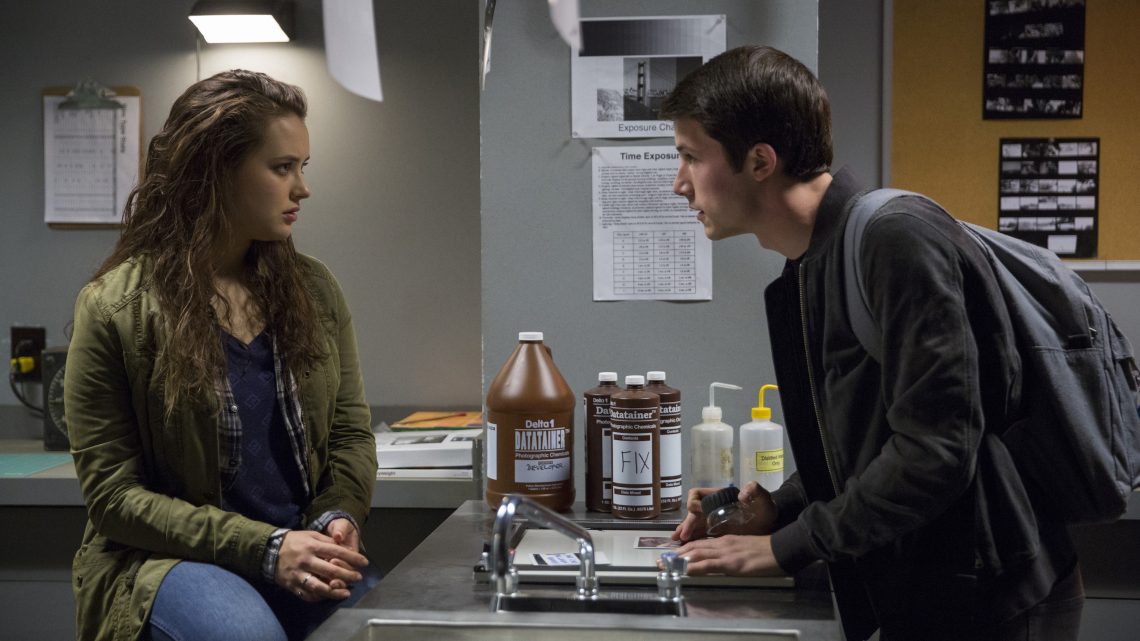
Is ’13 Reasons Why’ Really as Dangerous as People Say? It’s Complicated
May 3, 2019Suicide prevention experts were immediately worried when the trailer for 13 Reasons Why dropped on Netflix in 2017. The show is based on Jay Asher’s young adult novel of the same name and follows Clay Jensen (Dylan Minnette) as he listens to 13 tapes his classmate Hannah Baker (Katherine Langford) made before she died by suicide, explaining her “reasons why” she ended her life.
“Just sitting there watching the trailer was very disturbing to me,” said Lisa Horowitz, a clinical psychologist at the National Institute of Mental Health (NIMH), a branch of the National Institutes of Health (NIH). As someone who works to prevent suicide, she worried that a show that seemed to glorify a young woman’s death by suicide would have immense negative consequences. And it seems she had a right to be concerned, according to research she and her colleagues published on Sunday.
In a study supported by the NIH, Horowitz and her team found a 28.9 percent increase in teen suicide rates in the month following the show’s release compared to the five years prior. While other research looking into the effects of the show found that both Google searches for suicide-related terms and suicide admissions to one children’s hospital increased after its premiere, the NIH study is the first paper showing a link between suicide deaths and release of the show. Unsurprisingly, it’s gotten lots of media coverage.
Yet another recently published study claims, in a seeming contradiction, that watching the entire second season of 13 Reasons Why could have some mental health benefits, like fewer reports of self-harm or suicidal thoughts—though it should be noted that nearly a quarter of the young people in the study didn’t get through the whole season. Many of the news stories about the NIH study also mention this second paper, but (again, unsurprisingly) the headlines focused on a “spike” in teen suicide.
So what’s going on here—is one of these studies wildly off-base? Nope. Both studies are accurate (though each has its limitations), and both bring up important points about 13 Reasons Why and television’s portrayal of suicide, said Richard Shadick, a professor of psychology and director of the counseling center at Pace University. Shadick wasn’t involved with either study.
The important distinction, he said, is the season each team studied. The content and framing is pretty different in seasons one and two—and the latter ends on a more upbeat note than season one did. In the final episode of season one, we watch Hannah take her life. In the final episode of season two, Hannah’s parents hold a memorial service for their daughter and Clay, who’d been haunted by Hannah’s “ghost” all season, moves on. “I love you and I let you go,” he tells her.
What did the two studies find?
Horowitz and her team found that, in April 2017, one month after season one dropped on Netflix, the number of people ages 10 to 17 who died by suicide was greater than any other month in the prior five years and higher than what was projected for 2017. An increase of almost 30 percent seems very stark, but the suicide rate for that age group is low to begin with, making any increase look large. (They found no association between the show’s release and changes in suicide rates among people ages 18 to 29 or 30 to 64.)
Interestingly, the increase in deaths was driven mostly by boys, even though the show depicts a teenage girl’s death. Horowitz theorizes that may be because the study looked at suicide deaths, not suicide attempts—girls are more likely to attempt suicide, she said, but boys are more likely to die by suicide. Importantly, the researchers don’t know if the people who died by suicide watched the show or not.
Dan Romer, research director at the Annenberg Public Policy Center at the University of Pennsylvania, led the other study which looked exclusively at season two. Romer and his team recruited a group of 729 people ages 18 to 29 who had access to Netflix; 60 percent of them were students and 80 percent were women. They asked each person to complete two surveys measuring suicide risk, hopelessness, recent self-harm, and other mental health measures. Participants took one survey before Netflix released the second season of 13 Reasons Why in May 2018, and another one month afterward. In that follow-up survey, researchers asked whether each person watched the whole season, some of it, or didn’t watch at all.
People who said they watched all of season two reported less self-harm than those who didn’t watch at all, but those who stopped watching partway through reported greater depression and hopelessness than before they started watching. Romer’s team believes that being unable to finish the show was an indicator of pre-existing mental health distress. Being able to finish the season seemingly offered some comfort, and also appeared to encourage viewers to help others: When they were presented with a hypothetical situation in which a friend appears to be suicidal, those who watched the full second season said they were more likely to be sympathetic.
So, this study in itself seems to hold a contradiction: that the show might have both negative and positive effects. In an accompanying commentary, Anna Muller, an associate professor of comparative human development and sociology at the University of Chicago, wrote that the findings show the strongest evidence to date that 13 Reasons Why can harm some youth, but the results also suggest that it can help others—something we rarely consider when discussing the show.
Isn’t season two less upsetting to begin with? There’s no suicide in it.
But, again, when it comes to possibly influencing people vulnerable to suicidal ideation, the first and second seasons of 13 Reasons Why are two completely different beasts. “It makes sense why these studies seemingly contradict each other, but they’re really comparing apples to oranges,” Shadick said. The most dangerous parts of the show’s first season were either toned down or absent from season two, Shadick added.
“They depicted the suicide act in great detail [in season one],” Horowitz said. “To me, it was almost prescriptive,” almost like a how-to manual for suicide, she said. Beyond that, it also misrepresented the consequences of suicide. “It glorified [suicide] in a way,” Horowitz said.
Horowitz noted that Hannah Baker appears in every episode—her story is told through a series of flashbacks in season one and Clay frequently sees visions of Hannah in season two, as he works out his feelings about her death. Hannah’s continued existence, in one form or another, in both seasons could give some viewers the sense that her death resulted in the revenge she craved, and left her spirit there to watch each person who had a hand in her pain get what they deserved. Horowitz said it gave Hannah a ghost-like presence that made her death seem almost mystical and serene. But there’s an obvious problem with that depiction: “If you kill yourself, you’re dead,” she said.
The first season also undermined one of the tools suicide-prevention experts lean on heavily: confiding in a trusted adult. None of the adults in the show, not even Mr. Porter, the school counselor whose job it is to help distressed teens, was competent, Horowitz said. Mr. Porter is, in fact, the final person on Hannah’s list of reasons she chose to end her life, because she went to him to report a rape and he didn’t get her the help she needed. And that could give teenagers watching the show the impression that the adults in their lives who are there to help aren’t trustworthy.
In contrast, the season two takes measures to address the graphic content of the show. The beginning of each episode in season two starts with a trigger warning, which was never present in the first season. Trigger warnings are important because they give the viewer a choice to watch the episode or not—if they’re warned up front that an episode would depict graphic violence, they may decide not to watch. But even if they do choose to watch, the warnings may help prepare people emotionally for what they’re about to see. “If a viewer unexpectedly sees something particularly upsetting, they might have a very strong negative emotional reaction,” Shadick said. “If they’re prepared, they may be less likely to be shocked by the content.”
The second season of 13 Reasons Why was also naturally less dangerous when it came to influencing suicidal thoughts and actions because Hannah’s death had already happened. While the first season broke a major rule in the guidelines mental health organizations give for depicting suicide on screen by showing exactly how Hannah died, season two didn’t have that rule to break.
If I haven’t watched the show—or only saw season one—is it OK to watch or is it dangerous?
While Horowitz and Romer’s studies seem to contradict each other, they both agree that 13 Reasons Why—and entertainment media in general—have a responsibility to be more careful about depicting suicide. Romer found both the first and second seasons of 13 Reasons Why to be so graphic that he couldn’t finish watching, meaning that, just like some of the people in his study, he didn’t get to the more optimistic part of the show, like when we see Hannah’s family and classmates rally to get justice for her, through two separate lawsuits, and when we see them begin to move on from her death. By the end of season two, Hannah’s mom has closed their family pharmacy and plans to move to New York City, where Hannah had always dreamed of living.
When asked if he thinks people set on watching it should absolutely finish season two, Romer said it was difficult to give blanket advice.“It will depend on how well one thinks a person can handle the upsetting content,” he said. “Clearly, if someone can’t, they should stop or avoid it to begin with. But at the same time, if they can stomach it, then going to the end may pay off because they will see the hopeful ending and that will be therapeutic. This is why we suggested to the folks at 13 Reasons to try to make the story a bit more palatable as it unfolds so that the people who can benefit from it will stay to appreciate it.”
And while Horowitz did watch the show, she did it with a grimace and noted the many ways the producers could have done better in both seasons (though the second certainly did better than the first) simply by highlighting how to get help. But Hannah is still very present in season two—reinforcing the sense of life after death.
With the third season of 13 Reasons Why set to come out later this year, suicide prevention experts hope that the show continues to become more uplifting, and less graphic.
If you or someone you know is considering suicide, help is available. Call 1-800-273-8255 to speak with someone now or text START to 741741 to message with the Crisis Text Line.
Sign up for our newsletter to get the best of VICE delivered to your inbox daily.


